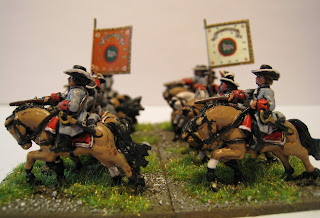For my last post of the year, I'm going back to last week when Richard and myself met up for another test game of Beneath the Lily Banners 2. We made a few mistakes in our first game and posted some questions on the League of Augsberg site, after some sound advice from the nice chaps there, we think were nearly there!!
We decided to place a village in the centre of the board for the French to attack. The French had 2 infantry brigades of 3 units, 2 horse brigades and a 3 Squadron Dragoon brigade. Most of the troops were drilled, but they had 1 guard unit and 3 Elite units. The Williamites also had 2 infantry brigades of 3 units, but only 1 of Horse and 1 of Dragoons. They had 2 elites and 2 raw units.
The setup.
The 1st Williamite Brigade containing the Elite Dutch Blue Guard, in the centre
the Raw Selwyn's regt and at the end of the hill, The Royal Scots.
The French setup, regt La Couronne holding the left flank.
My plan was to hold the hill and try and keep hold of the village. The main danger
being the 8 Squadron's of French Horse coming around the flank.
The French Horse advance. On the left are the Guard class Gendarmes Ecossais.
The 1st Dutch Horse brigade. 2 Squadrons each of regts Ittersom and Ginkel.
In the village are the raw Royal regt of Fuzileers. On the right, Prince
George's Danish regt, both on defend orders. with a small battalion gun
next to it, on the left, Lesley's regt.
At our last game we found the artillery to be, for want of a better word, Crap!
But my gun on the hill and Posties 2 guns opposite certainly changed our minds.
During the game La Courrone took 6 casualties due to artillery fire, and were pushed
back twice, never actually coming off the hill. This forced Posties to waste valuable movement
on them to keep them in the game, unfortunately due to some bad movement rolls this meant
the attack on the village was delayed. So I pushed my infantry forward instead.
A couple of bad movements rolls then ensued, with a no move and a 25% allowance.
Which meant I could only move 4 units!!! Damn!!
So the march to the French hill was halted, for two turns.
But at least I could move the Horse into a position to charge next turn, meanwhile
the French kept coming.
The charges then ensued. Both Ginkels and the French Gendarmes performed a all or nothing charge, while
Iittersom's failed to charge and took the charge at the halt....not good! The 1st squadron routed through the 2nd squadron then off the table edge. The 2nd were hit by the Ecossais as they followed up and were routed, then they failed to stop themselves pursuing after the 2nd squadron as they too routed off the table.
A close of of Ginkel's Horse and the French Gendarmes
While standing still for two turns, The Dutch Guard and Selwyn's were hammered by
the two French guns on the hill. The Orange markers represents the unit being Shaken.
Ginkel's Horse were victorious, and chased off the French Horse.
The next turn they turned to face another 2 Squadrons of French Horse.
And unfortunately we had to end the game there, as we'd run out of time. For our next game were going to try and limit the cavalry to a support role, as we've not got any infantry into melee yet!! It was another learning curve for both myself and Richard, also Postie now has had a taste of the rules, let's hope he decides not to sell his 25mm Sedgemoor collection now!!
If I had to call the game I would give it as a French victory, the Williamite left flank was now non-existant.
See you in 2012!!!
Ray








































